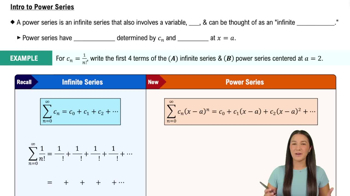1. State the half-angle identities used to integrate sin²x and cos²x.
Table of contents
- 0. Functions7h 54m
- Introduction to Functions16m
- Piecewise Functions10m
- Properties of Functions9m
- Common Functions1h 8m
- Transformations5m
- Combining Functions27m
- Exponent rules32m
- Exponential Functions28m
- Logarithmic Functions24m
- Properties of Logarithms36m
- Exponential & Logarithmic Equations35m
- Introduction to Trigonometric Functions38m
- Graphs of Trigonometric Functions44m
- Trigonometric Identities47m
- Inverse Trigonometric Functions48m
- 1. Limits and Continuity2h 2m
- 2. Intro to Derivatives1h 33m
- 3. Techniques of Differentiation3h 18m
- 4. Applications of Derivatives2h 38m
- 5. Graphical Applications of Derivatives6h 2m
- 6. Derivatives of Inverse, Exponential, & Logarithmic Functions2h 37m
- 7. Antiderivatives & Indefinite Integrals1h 26m
- 8. Definite Integrals4h 44m
- 9. Graphical Applications of Integrals2h 27m
- 10. Physics Applications of Integrals 3h 16m
- 11. Integrals of Inverse, Exponential, & Logarithmic Functions2h 34m
- 12. Techniques of Integration7h 41m
- 13. Intro to Differential Equations2h 55m
- 14. Sequences & Series5h 36m
- 15. Power Series2h 19m
- 16. Parametric Equations & Polar Coordinates7h 58m
7. Antiderivatives & Indefinite Integrals
Integrals of Trig Functions
Problem 8.6.27
Textbook Question
7–84. Evaluate the following integrals.
27. ∫ sin⁴(x/2) dx
 Verified step by step guidance
Verified step by step guidance1
Step 1: Recognize that the integral involves a power of sine, specifically sin⁴(x/2). To simplify this, use the power-reduction formula for sine: sin²(θ) = (1 - cos(2θ))/2. Rewrite sin⁴(x/2) as (sin²(x/2))².
Step 2: Substitute the power-reduction formula for sin²(x/2). Replace sin²(x/2) with (1 - cos(x))/2, since the argument of the sine function is x/2, and the double angle formula applies.
Step 3: Expand (1 - cos(x))/2 squared to get (1/4)(1 - 2cos(x) + cos²(x)). This simplifies the integrand into terms that can be integrated individually.
Step 4: For cos²(x), use the power-reduction formula again: cos²(x) = (1 + cos(2x))/2. Substitute this into the expanded integrand.
Step 5: Break the integral into separate terms: ∫(1/4)dx, ∫(-1/2)cos(x)dx, and ∫(1/8)(1 + cos(2x))dx. Integrate each term individually using basic integration rules for constants and trigonometric functions.
 Verified video answer for a similar problem:
Verified video answer for a similar problem:This video solution was recommended by our tutors as helpful for the problem above
Video duration:
3mPlay a video:
Was this helpful?
Key Concepts
Here are the essential concepts you must grasp in order to answer the question correctly.
Integration
Integration is a fundamental concept in calculus that involves finding the accumulated area under a curve represented by a function. It is the reverse process of differentiation and is used to compute quantities such as areas, volumes, and total accumulated change. Understanding the rules and techniques of integration, such as substitution and integration by parts, is essential for evaluating integrals.
Recommended video:

Integration by Parts for Definite Integrals
Trigonometric Functions
Trigonometric functions, such as sine and cosine, are periodic functions that relate angles to ratios of sides in right triangles. In calculus, these functions often appear in integrals and derivatives. Recognizing the properties and identities of trigonometric functions, such as sin²(x) + cos²(x) = 1, is crucial for simplifying expressions and solving integrals involving trigonometric terms.
Recommended video:

Introduction to Trigonometric Functions
Power Reduction Formulas
Power reduction formulas are trigonometric identities that allow us to express higher powers of sine and cosine in terms of first powers. For example, the formula sin²(x) = (1 - cos(2x))/2 can be used to simplify integrals involving sin⁴(x/2). These formulas are particularly useful in integration, as they transform complex expressions into simpler forms that are easier to integrate.
Recommended video:

Intro to Power Series

 5:28m
5:28mWatch next
Master Integrals Resulting in Basic Trig Functions with a bite sized video explanation from Patrick
Start learningRelated Videos
Related Practice
Textbook Question
69
views
